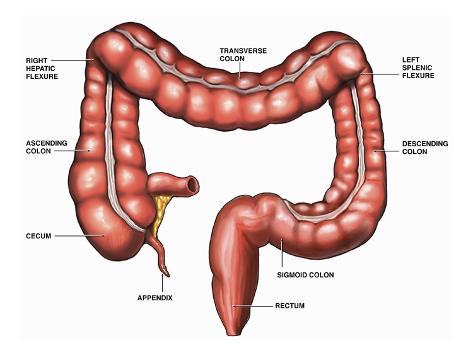Large Intestine
Large Intestine-
This is about 1.5 metres long, beginning at the caecum in the right iliac fossa and terminating at the rectum and anal canal deep in the pelvis.
Large intestine or colon extends from ileocecal valve up to anus.
Parts of Large Intestine-
Large intestine is made up of the following parts-
- Cecum with appendix -This is the first part of the colon. It is a dilated region which has a blind end inferiorly and is continuous with the ascending colon superiorly. Just below the junction of the two the ileocaecal valve opens from the ileum. The vermiform appendix is a fine tube, closed at one end, which leads from the caecum.
- Ascending colon- This passes upwards from the caecum to the level of the liver where it curves acutely to the left at the hepatic flexure to become the transverse colon.
- Transverse colon- This is a loop of colon which extends across the abdominal cavity in front of the duodenum and the stomach to the area of the spleen where it forms the splenic flexure and curves acutely downwards to become the descending colon.
- Descending colon- This passes down the left side of the abdominal cavity then curves towards the midline. After it enters the true pelvis it is known as the sigmoid colon.
- Sigmoid colon or pelvic colon- This part describes an S-shaped curve in the pelvis then continues downwards to become the rectum.
- Rectum- This is a slightly dilated section of the colon about 13 cm long. It leads from the sigmoid colon and terminates in the anal canal.
- Anal canal- This is a short passage about 3.8 cm long in the adult and leads from the rectum to the exterior. Two sphincter muscles control the anus; the internal sphincter, consisting of smooth muscle fibres, is under the control of the autonomic nervous system and the external sphincter, formed by skeletal muscle, is under voluntary control.

Structure of Wall of Large Intestine-
Wall of large intestine is formed by four layers of structures like any other part of the gut.
- Serous layer-
It is formed by peritoneum
- Muscular layer-
Smooth muscles of large intestine are distributed in two layers, namely the outer longitudinal layer and inner circular layer. The longitudinal muscle fibers of large intestine are arranged in the form of three long bands called tenia coli. The length of the tenia coli is less when compared to the length of large intestine. Because of this, the large intestine is made into series of pouches called haustra.
- Submucus layer-
It is not well developed in large intestine 4. Mucus layer: The crypts of Leiberkühn are present in mucosa of large intestine. But the villi, which are present in mucus membrane of small intestine, are absent in the large intestine. Only mucus-secreting glands are present in the mucosa of large intestine.
Function of Large Intestine-
- Absorptive Function –
Large intestine plays an important role in the absorption of various substances such as –
- Water
- Electrolytes
- Organic substances like glucose
- Alcohol
- Drugs like anesthetic agents, sedatives and steroids.
- Formation of Feces –
After the absorption of nutrients, water and other substances, the unwanted substances in the large intestine form feces. This is excreted out.
- Excretory Function –
Large intestine excretes heavy metals like mercury, lead, bismuth and arsenic through feces.
- Secretory Function –
Large intestine secretes mucin and inorganic substances like chlorides and bicarbonates.
- Synthetic Function-
Bacterial flora of large intestine synthesizes folic acid, vitamin B12 and vitamin K. By this function, large intestine contributes in erythropoietic activity and blood clotting mechanism.